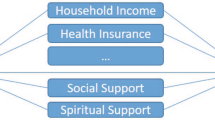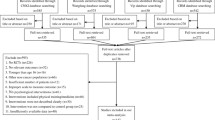Abstract
Mediation analysis allows the examination of effects of a third variable (mediator/confounder) in the causal pathway between an exposure and an outcome. The general multiple mediation analysis method (MMA), proposed by Yu et al., improves traditional methods (e.g., estimation of natural and controlled direct effects) to enable consideration of multiple mediators/confounders simultaneously and the use of linear and nonlinear predictive models for estimating mediation/confounding effects. Previous studies find that compared with non-Hispanic cancer survivors, Hispanic survivors are more likely to endure anxiety and depression after cancer diagnoses. In this paper, we applied MMA on MY-Health study to identify mediators/confounders and quantify the indirect effect of each identified mediator/confounder in explaining ethnic disparities in anxiety and depression among cancer survivors who enrolled in the study. We considered a number of socio-demographic variables, tumor characteristics, and treatment factors as potential mediators/confounders and found that most of the ethnic differences in anxiety or depression between Hispanic and non-Hispanic white cancer survivors were explained by younger diagnosis age, lower education level, lower proportions of employment, less likely of being born in the USA, less insurance, and less social support among Hispanic patients.




Similar content being viewed by others
References
Albert, J. M. (2008). Mediation analysis via potential outcomes models. Statistics in Medicine, 27(8), 1282–1304.
Alwin, D. F., & Hauser, R. M. (1975). The decomposition of effects in path analysis. American Sociological Review, 40(1), 37.
Avin, C., Shpitser, I., & Pearl, J. (2005). Identifiability of path-specific effects. In M. van Zaanen, T. Oates, G. Paliouras, & C. de la Higuera (Eds.), Proceedings of the international joint conference on artificial intelligence IJCAI-05. Edinburgh: Morgan-Kaufmann Publishers.
Baron, R., & Kenny, D. (1986). The moderator–mediator variable distinction in social psychological research: Conceptual, strategic, and statistical considerations. Journal of Personality and Social Psychology, 51(6), 1173–1182.
Breiman, L., Friedman, J., Olshen, R. A., & Stone, C. (1984). Classification and regression trees. Pacific Grove: Wadsworth.
Culver, J. L., Arena, P. L., Antoni, M. H., & Carver, C. S. (2002). Coping and distress among women under treatment for early stage breast cancer: Comparing African Americans, Hispanics and non-Hispanic Whites. Psycho-Oncology, 11(6), 495–504.
Fan, Y. (2012). Multiple mediation analysis with general predictive models, Dissertation. New Orleans, LA: Louisiana State University Health Sciences Center.
Friedman, J. (2001). Greedy function approximation: A gradient boosting machine. The Annals of Statistics, 29, 1189–1232.
Gallicchio, L., Calhoun, C., & Helzlsouer, K. J. (2013). Association between race and physical functioning limitations among breast cancer survivors. Supportive Care in Cancer, 22(4), 1081–1088.
Gu, C. (2013). Smoothing spline ANOVA models. New York: Springer.
Have, T. R. T., Joffe, M. M., Lynch, K. G., Brown, G. K., Maisto, S. A., & Beck, A. T. (2007). Causal mediation analyses with rank preserving models. Biometrics, 63(3), 926–934.
Jensen, R. E., Moinpour, C. M., Keegan, T. H. M., Cress, R. D., Wu, X.-C., & Paddock, L. (2017). The measuring your health study: Leveraging community-based cancer registry recruitment to establish a large, diverse cohort of cancer survivors for analyses of measurement equivalence and validity of the patient reported outcomes measurement information system (promis) short form items. Psychological Test and Assessment Modeling, 58(1), 99–117.
Jensen, R. E., Moinpour, C. M., Potosky, A. L., Lobo, T., Hahn, E. A., Hays, R. D., et al. (2016). Responsiveness of 8 patient-reported outcomes measurement information system (PROMIS) measures in a large, community-based cancer study cohort. Cancer, 123(2), 327–335.
Jensen, R. E., Potosky, A. L., Reeve, B. B., Hahn, E., Cella, D., Fries, J., et al. (2015). Validation of the PROMIS physical function measures in a diverse US population-based cohort of cancer patients. Quality of Life Research, 24(10), 2333–2344.
Judd, C. M., & Kenny, D. A. (1981). Process analysis: Estimating mediation in treatment evaluations. Evaluation Review, 5(5), 602–619.
MacKinnon, D. P. (2000). Equivalence of the mediation, confounding and suppression effect. Prevention Science, 1(4), 173–181.
Mackinnon, D. P. (2008). Introduction to statistical mediation analysis. New York: Lawrence Erlbaum Associates.
Mackinnon, D. P., & Dwyer, J. H. (1993). Estimating mediated effects in prevention studies. Evaluation Review, 17(2), 144–158.
NIH. Calibration studies testing. http://www.nihpromis.org/science/calibrationtesting. Accessed 09 Feb 2017.
NIH. Promis domain frameworks. http://www.nihpromis.org/measures/domainframework. Accessed 09 Feb 2017.
NIH. Promis methodology. http://www.nihpromis.org/science/methodology. Accessed 09 Feb 2017.
Patrick, D., & Erickson, P. (1993). Health policy, quality of life: Health care evaluation and resource allocation. New York, NY: Oxford University Press.
Pearl, J. (2001). Direct and indirect effects. In Proceedings of the seventeenth conference on uncertainty and artificial intelligence. Morgan Kaufmann.
Reeve, B. B., Potosky, A. L., Smith, A. W., Han, P. K., Hays, R. D., Davis, W. W., et al. (2009). Impact of cancer on health-related quality of life of older americans. JNCI Journal of the National Cancer Institute, 101(12), 860–868.
Reeve, B. B., Stover, A. M., Jensen, R. E., Chen, R. C., Taylor, K. L., Clauser, S. B., et al. (2012). Impact of diagnosis and treatment of clinically localized prostate cancer on health-related quality of life for older Americans. Cancer, 118(22), 5679–5687.
Reeve, B. B., & Terest, J. A. (2016). Overview to the two-part series: Measurement equivalence of the patient reported outcomes measurement information system (promis) short forms. Psychological Test and Assessment Modeling, 58(1), 31–35.
Reeve, B. B., Thissen, D., DeWalt, D. A., Huang, I.-C., Liu, Y., Magnus, B., et al. (2015). Linkage between the PROMIS® pediatric and adult emotional distress measures. Quality of Life Research, 25(4), 823–833.
Robins, J. M., & Greenland, S. (1992). Identifiability and exchangeability for direct and indirect effects. Epidemiology, 3(2), 143–155.
Rodenberg, C. A. (2006). A review of: Assessing quality of life in clinical trials: Theory and methods, second edition, by P. Fayers and R. Hays (eds.). Journal of Biopharmaceutical Statistics, 16(5), 761–763.
Teresi, J. A., Ocepek-Welikson, K., Kleinman, M., Ramirez, M., & Kim, G. (2016a). Measurement equivalence of the patient reported outcomes measurement information system (promis) anxiety short forms in ethnically diverse groups. Psychological Test and Assessment Modeling, 58(1), 183–219.
Teresi, J. A., Ocepek-Welikson, K., Kleinman, M., Ramirez, M., & Kim, G. (2016b). Psychometric properties and performance of the patient reported outcomes measurement information system (promis) depression short forms in ethnically diverse groups. Psychological Test and Assessment Modeling, 58(1), 141–181.
VanderWeele, T. J. (2009). Marginal structural models for the estimation of direct and indirect effects. Epidemiology, 20(1), 18–26.
VanderWeele, T. J., & Robinson, W. R. (2014). On the causal interpretation of race in regressions adjusting for confounding and mediating variables. Epidemiology, 25(4), 473–484.
Vanderweele, T. J., & Vansteelandt, S. (2009). Conceptual issues concerning mediation, interventions and composition. Statistics and Its Interface, 2(4), 457–468.
VanderWeele, T., Vansteelandt, S., & Daniel, R. M. (2014). Effect decomposition in the presence of an exposure-induced mediator-outcome confounder. Epidemiology, 25(2), 300–306.
Vansteelandt, S., & Daniel, R. M. (2017). Interventional effects for mediation analysis with multiple mediators. Epidemiology, 28(2), 258–265.
Yost, K., Eton, D., Garcia, S., & Cella, D. (2011). Minimally important differences were estimated for six promis cancer scales in advanced-stage cancer patients. Journal of Clinical Epidemiology, 64(5), 507–516.
Yu, Q., Fan, Y., & Wu, X. (2014). General multiple mediation analysis with an application to explore racial disparities in breast cancer survival. Journal of Biometrics & Biostatistics, 5(189), 189.
Yu, Q., & Li, B. (2017). mma: An r package for multiple mediation analysis. Journal of Open Research Software, 5, 11.
Yu, Q., Li, B., & Scribner, R. A. (2009). Hierarchical additive modeling of nonlinear association with spatial correlations—An application to relate alcohol outlet density and neighborhood assault rates. Statistics in Medicine, 28(14), 1896–1912.
Yu, Q., Scribner, R., Leonardi, C., Zhang, L., Park, C., Chen, L., et al. (2017). Exploring racial disparity in obesity: A mediation analysis considering geo-coded environmental factors. Spatial and Spatio-temporal Epidemiology, 21, 13–23.
Funding
This study was partially funded by the NIMHD award # 1R15MD012387 and by the Louisiana State University Health Sciences Center Pilot Fund.
Author information
Authors and Affiliations
Corresponding author
Ethics declarations
Conflict of interest
The authors declare that they have no conflict of interest.
Ethical Approval
This article does not contain any studies with human participants or animals performed by any of the authors.
Electronic supplementary material
Below is the link to the electronic supplementary material.
Rights and permissions
About this article
Cite this article
Yu, Q., Medeiros, K.L., Wu, X. et al. Nonlinear Predictive Models for Multiple Mediation Analysis: With an Application to Explore Ethnic Disparities in Anxiety and Depression Among Cancer Survivors. Psychometrika 83, 991–1006 (2018). https://doi.org/10.1007/s11336-018-9612-2
Received:
Revised:
Published:
Issue Date:
DOI: https://doi.org/10.1007/s11336-018-9612-2




